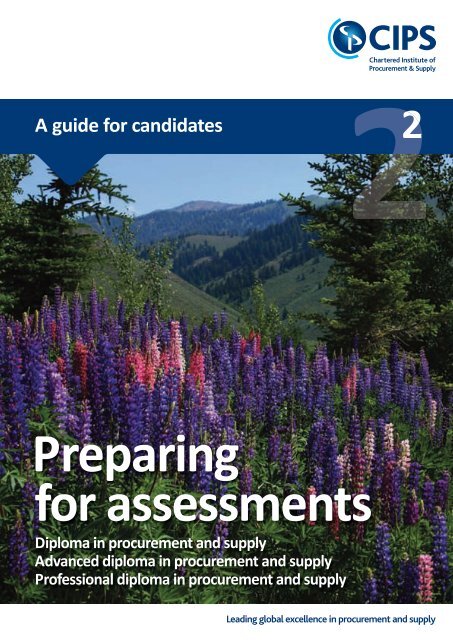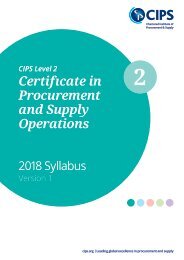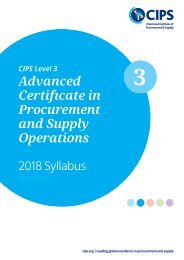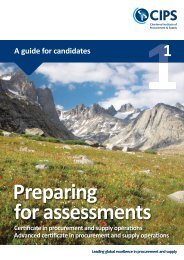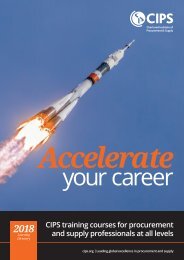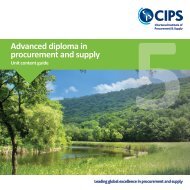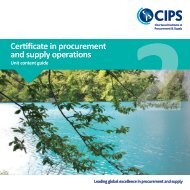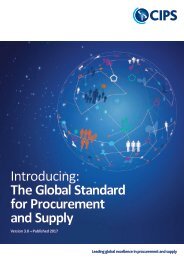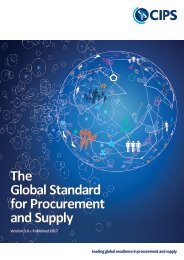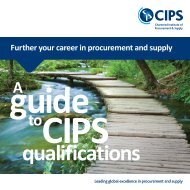Preparing for CIPS Diploma level assessments
Create successful ePaper yourself
Turn your PDF publications into a flip-book with our unique Google optimized e-Paper software.
A guide <strong>for</strong> candidates<br />
2<br />
<strong>Preparing</strong><br />
<strong>for</strong> <strong>assessments</strong><br />
<strong>Diploma</strong> in procurement and supply<br />
Advanced diploma in procurement and supply<br />
Professional diploma in procurement and supply<br />
Leading global excellence in procurement and supply
<strong>Preparing</strong> <strong>for</strong><br />
<strong>assessments</strong><br />
Improving your technique could be the difference between a pass and a fail, so it’s<br />
important to spend some time thinking about what you should be doing correctly.<br />
<strong>CIPS</strong> has produced two new guides to assist you in<br />
preparing <strong>for</strong> each of the assessment <strong>for</strong>mats you<br />
are likely to encounter when taking <strong>CIPS</strong><br />
qualifications. Hints and techniques <strong>for</strong> each<br />
<strong>for</strong>mat are covered in each guide, and you should<br />
use the relevant guide <strong>for</strong> the qualification or unit<br />
you are about to take. Everyone works in different<br />
ways, so these guides can only offer you some<br />
helpful advice – it is not intended that everyone<br />
should follow the advice, or prepare <strong>for</strong> their<br />
<strong>assessments</strong> in the same way.<br />
Whatever the assessment <strong>for</strong>mat, the purpose of<br />
the questions is <strong>for</strong> you to: demonstrate your<br />
knowledge and understanding about the subject<br />
area and show that you can adhere to<br />
instructions when answering questions.<br />
ASSESSMENT GUIDE 1<br />
<strong>Preparing</strong> <strong>for</strong> <strong>assessments</strong>:<br />
Certificate in procurement and supply operations<br />
Advanced certificate in procurement and supply operations<br />
• Section 1 – Answering multiple choice questions<br />
• Section 2 – Practical written assessment preparation guide.<br />
ASSESSMENT GUIDE 2<br />
<strong>Preparing</strong> <strong>for</strong> <strong>assessments</strong>:<br />
<strong>Diploma</strong> in procurement and supply operations<br />
Advanced diploma in procurement and supply<br />
Professional diploma in procurement and supply<br />
<strong>CIPS</strong> 2013 suite of professional qualifications<br />
provides a ladder of learning opportunities to suit<br />
all the different stages of a procurement career.<br />
Our qualifications are available worldwide, and<br />
are mapped against qualification frameworks<br />
around the world to ensure that they are<br />
recognised wherever you are based.<br />
Five qualifications are available, unit titles are<br />
shown opposite:<br />
Unit content guides, giving further detail of the learning<br />
outcomes <strong>for</strong> each unit, can be found on <strong>CIPS</strong>’ website.<br />
• Section 1 – <strong>Preparing</strong> <strong>for</strong> essay questions<br />
• Section 2 – A guide to preparing <strong>for</strong> unseen case study and questions<br />
• Section 3 – A guide to preparing <strong>for</strong> pre-released case study and questions.<br />
Certificate in<br />
procurement and<br />
supply operations<br />
CORE UNITS<br />
• Procurement<br />
and supply<br />
principles<br />
• Procurement<br />
and supply<br />
functions<br />
• Procurement<br />
and supply<br />
processes<br />
• Procurement<br />
and supply<br />
administration<br />
• Procurement<br />
and supply<br />
stakeholders.<br />
Advanced certificate<br />
in procurement and<br />
supply operations<br />
CORE UNITS<br />
• Procurement<br />
and supply<br />
environments<br />
• Procurement<br />
and supply<br />
operations<br />
• Procurement<br />
and supply<br />
workflow<br />
• Inventory and<br />
logistics<br />
operations<br />
• Procurement<br />
and supply<br />
relationships.<br />
<strong>Diploma</strong> in<br />
procurement<br />
and supply<br />
CORE UNITS<br />
• Contexts of<br />
procurement<br />
and supply<br />
• Business needs<br />
in procurement<br />
and supply<br />
• Sourcing in<br />
procurement<br />
and supply<br />
• Negotiating and<br />
contracting in<br />
procurement<br />
and supply<br />
• Managing<br />
contracts and<br />
relationships in<br />
procurement<br />
and supply.<br />
Advanced diploma<br />
in procurement<br />
and supply<br />
CORE UNITS<br />
• Management in<br />
procurement and<br />
supply<br />
• Managing risks in<br />
supply chains<br />
• Improving the<br />
competitiveness<br />
of supply chains.<br />
OPTIONAL UNITS<br />
• Category<br />
management in<br />
procurement and<br />
supply<br />
• Sustainability in<br />
supply chains<br />
• Operations<br />
management in<br />
supply chains.<br />
Professional diploma<br />
in procurement<br />
and supply<br />
CORE UNITS<br />
• Leadership in<br />
procurement<br />
and supply<br />
• Corporate and<br />
business<br />
strategy<br />
• Strategic supply<br />
chain<br />
management.<br />
OPTIONAL UNITS<br />
• Supply chain<br />
diligence<br />
• Programme and<br />
project<br />
management<br />
• Legal aspects in<br />
procurement<br />
and supply<br />
(UK).<br />
www.cips.org 03
General advice<br />
<strong>for</strong> allassessment<br />
types<br />
Whatever the <strong>for</strong>mat, the purpose of the questions is <strong>for</strong> you to:<br />
A demonstrate your knowledge and understanding about the subject area, and<br />
B show that you can adhere to instructions when answering questions<br />
It is important to consider both these aspects when preparing <strong>for</strong> and during <strong>assessments</strong>. If you<br />
are taking an assessment involving essays or case studies, always remember to demonstrate,<br />
what you know throughout your answers. The person marking your essay does not know you, so<br />
you need to show your knowledge in a similar way to approaching a job interview – you have to<br />
help them to recognise that you know your material, and if you don’t, the assessor will not make<br />
any allowances <strong>for</strong> what you missed out!<br />
Memory aids <strong>for</strong> revision, and to improve recall during the assessment:<br />
1 Many people claim to have a ‘bad memory’, but often the problem is that they don’t give the in<strong>for</strong>mation sufficient<br />
attention to commit it to their memory in the first place. If the in<strong>for</strong>mation never made it to your memory, then you have<br />
no hope of getting it out again. So the most important aid to memory is to PAY ATTENTION:<br />
• focus on what you are learning or revising, and don’t let your mind wander. Many people find that certain types of<br />
music (often instrumental music) help concentration, but most people cannot concentrate properly with the TV playing.<br />
• make sure you understand the concepts you are learning – if you don’t understand them, you will not remember them<br />
• re-phrase or re-state the in<strong>for</strong>mation, so that you are <strong>for</strong>ced to think about what it means<br />
• if you have to remember lists, repeat the items enough times to lodge them in your memory<br />
2 Use a mnemonic to help you remember lists, theories, or staged processes.<br />
For example, recognised management theorists include: Mullins, Brech, Armstrong, Fayol, Mintzberg, Drucker<br />
You can devise a simple mnemonic to help you remember their names using their initial letters:<br />
Most British Accountants Find Maths Difficult<br />
If you devise your own mnemonics, they are usually easier to remember than someone else’s. If you can make them funny<br />
or personal to you, they are easier still to remember.<br />
3 Visual memory often helps to support recall of in<strong>for</strong>mation <strong>for</strong> an assessment. If this works <strong>for</strong> you<br />
• make charts, mind-maps, tables or pictures while revising – you may find you can recall these better during the<br />
assessment than sections of text<br />
• use coloured highlighters in your revision notes, choosing different colours <strong>for</strong> different topics or related concepts. If a<br />
question on one of these topics comes up in the assessment, you may be able to recall relevant in<strong>for</strong>mation by<br />
remembering the items that you had highlighted in the same colour.<br />
4 Research shows that re-creating the circumstances you were in when you were revising helps you to recall better in the<br />
assessment. Clearly, you can’t take your classroom or bedroom into the assessment room, but one tip you might try is to<br />
wear a particular perfume or aftershave whilst revising. Wear it again on the day of the assessment, and the smell may<br />
help you to recall the in<strong>for</strong>mation you need.<br />
Revising <strong>for</strong> <strong>CIPS</strong> <strong>assessments</strong><br />
Plan a<br />
timetable <strong>for</strong><br />
revision and<br />
break up each<br />
area into<br />
manageable<br />
chunks<br />
Stick pieces of<br />
paper around<br />
your room<br />
with notes and<br />
look at them<br />
regularly.<br />
Tip and hints<br />
• Use the unit content learning outcomes as a<br />
check-list of all the things you need to know.<br />
• Make your own notes, rather than relying on<br />
books, or notes provided by lecturers. You<br />
may like to summarise your notes on cards<br />
that you can carry round with you. If you are<br />
a ‘visuals’ person, make mind-maps instead of<br />
linear notes. Use highlighters and coloured<br />
pens to focus on important things.<br />
• Use your mobile phone or an online voice<br />
recorder (there are lots of free voice<br />
recorders online) to record your voice. Record<br />
yourself reading your notes or summaries<br />
and then listen to the recordings.<br />
• Use past papers and/or exemplar material<br />
from <strong>CIPS</strong> website to gain an understanding<br />
of how the assessors design questions on the<br />
topics you have studied, but remember that<br />
the assessment <strong>for</strong>mats changed in 2013, so<br />
you should treat pre-2013 past papers with<br />
caution. Exemplar material <strong>for</strong> each unit of<br />
the 2013 qualifications can also be found on<br />
<strong>CIPS</strong> website.<br />
• Read any assessor reports and guidance<br />
provided by <strong>CIPS</strong>.<br />
• Get as much practice as you can: make sure<br />
you can concentrate <strong>for</strong> 2-3 hours at a time,<br />
try to get used to writing in time-constrained<br />
conditions, and practise extended writing if<br />
you are preparing <strong>for</strong> essay-type assessment.<br />
• Revise with a friend. Explain things to each<br />
other and ask each other some questions. Go<br />
<strong>for</strong> a walk with a friend and test each other<br />
while you are walking.<br />
• Take regular breaks, perhaps of around ten<br />
minutes, to avoid revision-fatigue. Start by<br />
revising <strong>for</strong> short periods between breaks,<br />
then gradually lengthen the revision time, but<br />
keep the break-times the same. Make extra<br />
time <strong>for</strong> revision during the day by getting up<br />
earlier, or shortening your lunch break.<br />
On the day of the assessment:<br />
• Eat properly be<strong>for</strong>e the assessment to keep<br />
your blood sugar and energy <strong>level</strong>s up. Make<br />
sure you drink plenty of water to keep you<br />
hydrated.<br />
• Try to remain relaxed. Take deep breaths and,<br />
if possible, try to stretch. This can help clear<br />
your mind and relieve any build-up of<br />
tension.<br />
• If you have a sudden ‘mental block’ during<br />
the assessment, try not to panic - this is quite<br />
a common problem! If it happens to you,<br />
some of the following techniques may help:<br />
Leave space and move to the next<br />
question. This will give you confidence and<br />
give you time to clear your head<br />
Answer questions you feel confident about<br />
first – just remember to clearly show the<br />
question numbers<br />
Try to recall the in<strong>for</strong>mation using one of<br />
the memory aids above. If you have used<br />
these methods during revision. You can<br />
make notes in your answer booklet once<br />
the assessment has started. Jot down<br />
thoughts as they occur to you when you<br />
read through the paper, to see if this<br />
triggers recall<br />
• Pace yourself – make sure you know how<br />
much time to allocate to each question or<br />
section (we have given you some<br />
recommended timings at the end of each<br />
section of this guide) and stick to your plan.<br />
Be prepared. If<br />
you feel<br />
confident and<br />
know what to<br />
expect it can<br />
have a really<br />
positive effect<br />
on your state of<br />
mind and <strong>level</strong><br />
of nerves.<br />
www.cips.org 05
1 Essay <strong>assessments</strong><br />
what to expect<br />
Essay-style questions<br />
preparation guide<br />
How to prepare <strong>for</strong> essay questions<br />
<strong>Diploma</strong> in procurement<br />
& supply.<br />
Three hours duration<br />
Advanced diploma in<br />
procurement & supply.<br />
Three hours duration<br />
Professional diploma in<br />
procurement & supply.<br />
Three hours duration<br />
D1: Contexts of procurement and supply.<br />
D2: Business needs in procurement and supply.<br />
D4: Negotiating and contracting in<br />
procurement and supply.<br />
D5: Managing contracts and relationships in<br />
procurement and supply.<br />
AD4: Category management in procurement<br />
and supply.<br />
AD5: Sustainability in supply chains.<br />
AD6: Operations management in supply<br />
chains.<br />
PD2: Corporate and business strategy.<br />
PD4: Supply chain diligence.<br />
PD5: Programme and project management.<br />
PD6: Legal aspects in procurement and<br />
supply (UK).<br />
Four questions<br />
each worth 25<br />
marks, each testing<br />
a different learning<br />
outcome. The pass<br />
mark is 50%.<br />
As above.<br />
As above.<br />
The following units are covered later in this guide: D3: Sourcing in procurement and supply, AD1:<br />
Management in procurement and supply, AD2: Managing risk in supply chains, AD3: Improving<br />
competitiveness of supply chains, PD1: Leadership in procurement & supply and PD3: Strategic<br />
supply chain management.<br />
Timing is everything<br />
• Spend 5 minutes reading the instructions and<br />
questions through at least twice – it is worth<br />
reading all the questions on the paper so that<br />
you have an overall picture of what is being<br />
asked, be<strong>for</strong>e you focus attention on each of the<br />
questions some of which may have several<br />
parts. This is so that you can make sure that you<br />
have established the focus of each question, and<br />
avoid straying into material that you might need<br />
to use in other questions. Some questions may<br />
contain a brief scenario or a contextual<br />
statement, probably only two or three lines<br />
long. This is not a case study, which would be<br />
considerably longer<br />
• You will need to decide how to allocate your time<br />
<strong>for</strong> each question. At the end of this section you<br />
will find a table that gives you some<br />
recommended timings <strong>for</strong> answering essay<br />
questions. Be ready to stop writing the essay<br />
when your allocated time runs out! If you do not<br />
move on to the next question, you are likely to run<br />
out of time and fail to gain marks overall. If you are<br />
struggling with completing your first and second<br />
essays in the time you have allocated, then you<br />
will need to review your plans <strong>for</strong> the other<br />
questions, in order to make sure you complete as<br />
many answers to questions as possible.<br />
Reading the questions and planning<br />
your answers<br />
• As you read through the paper, identify what is<br />
being asked of you in each question. Remember,<br />
there will be one question <strong>for</strong> each of the<br />
learning outcomes from the Unit Content Guide:<br />
Determine which part of the subject unit<br />
content the question relates to<br />
Consider what key issues the question is asking<br />
you to write about, so that you are sure you<br />
fully understand the demands of the question.<br />
Format, context, task and outputs are very<br />
important<br />
Check the number of marks allocated to each<br />
question or part of a question: this helps you to<br />
work out how much in<strong>for</strong>mation the assessors<br />
are expecting you to include in your answer to<br />
each part<br />
Take careful note if the question asks you to<br />
provide a specific number of examples or<br />
ideas – make sure you provide the number<br />
required.<br />
Example<br />
Discuss FOUR advantages and FOUR disadvantages of a winlose<br />
approach to negotiation. (16 marks).<br />
Make sure you give four of each, no less. Two marks are<br />
allocated <strong>for</strong> each one, so you cannot earn marks if you do not<br />
provide the required number, no matter how detailed your<br />
discussion may be of the advantages/ disadvantages you include.<br />
• Next, highlight the command words in each<br />
question or part of a question. (See General<br />
advice <strong>for</strong> preparing <strong>for</strong> any assessment <strong>for</strong><br />
examples of command words, and what they<br />
mean):<br />
Make sure you understand exactly what you<br />
are being asked to do: ‘Explain’ means you<br />
must not just describe something; ‘Compare<br />
and contrast’ means you should look <strong>for</strong><br />
points of similarity and difference in the items<br />
given – it is all too easy to <strong>for</strong>get this once you<br />
start writing.<br />
Example<br />
Explain, with examples, the difference between direct and<br />
indirect costs. (10 marks)<br />
If you do not give examples to illustrate your explanation, you<br />
will fail to gain marks. In the example given here, failure to<br />
include any examples would cost you 50% of the marks available.<br />
• Make sure that, even if a question sounds<br />
familiar to one you may have practised, you have<br />
checked the intent of the question on the paper<br />
– a difference in the command word may require<br />
a completely different type of answer from the<br />
one you have practised. Be careful not to simply<br />
repeat answers you have already prepared<br />
previously and remembered: make sure you<br />
answer the specific question asked, using your<br />
knowledge and understanding.<br />
www.cips.org<br />
07
Writing your answers<br />
• Remember to write down a few notes about<br />
the question so that you can refer back to<br />
these when you begin to write your answer.<br />
Use your answer booklet to do this – notes<br />
should be crossed out towards the end of the<br />
assessment; your assessor will not mark these<br />
• It is obviously easier to write answers to the<br />
parts of questions which are worth relatively<br />
few marks. For longer answers however, it is<br />
worthwhile taking time to plan your answer in<br />
order to organise your thoughts<br />
• Plan by noting down any and all relevant<br />
points that come to mind. At this stage, do not<br />
worry about order or structure<br />
• Once you have some notes, you can then<br />
begin to organise your thoughts.<br />
• Identify which points can be drawn together<br />
<strong>for</strong> say, a paragraph of your answer<br />
• Identify any models, theories or examples<br />
which will add value to your answer if<br />
appropriate<br />
• Write your essay to the plan you have made,<br />
making each substantive point clear and<br />
concise, and written in a way that answers the<br />
question<br />
• You may wish to use sub-headings and/or<br />
underlining of key points in your text, to<br />
emphasise points in your answer<br />
• It is good practice where possible to introduce<br />
your essay with reference to theories, models,<br />
or to a particular business context. This helps<br />
to show the assessor what you know about<br />
the concepts being assessed, but you should<br />
try to keep this brief as it may not add to your<br />
marks if you spend too long ‘setting the<br />
scene’. If referencing authors in your answer,<br />
reference them properly. It may be better to<br />
discuss their views in broad terms, rather than<br />
attempt to quote them if you aren’t sure<br />
• Always say why you have referred to a<br />
particular theory or model – it should add<br />
value to your answer not just fill up space<br />
because you can’t think what else to put<br />
Example<br />
Discuss the benefits and challenges associated with the<br />
implementation of an MRP system. (10 marks)<br />
You may wish to preface your answer with a short paragraph showing<br />
your understanding of MRP systems, be<strong>for</strong>e going on to discuss their<br />
benefits and limitations. Ensure your answer discusses both benefits<br />
and challenges. If you do not address one of these within your answer<br />
it will mean you fail to gain up to 5 marks.<br />
• Questions involving comparison or<br />
evaluation may require a summary<br />
paragraph in which you pull together the<br />
points you have been making and draw<br />
conclusions at the end. You should make a<br />
note, be<strong>for</strong>e you begin to write, what<br />
conclusions you intend to draw and work<br />
towards them as you present your<br />
arguments.<br />
General advice <strong>for</strong> candidates<br />
• Start each answer on a new page, leaving<br />
space after completing the previous essay.<br />
This enables you to include a few words<br />
more, on review of your answer, should<br />
another aspect of the points you have made<br />
come to mind. Leaving space also makes it<br />
easier <strong>for</strong> the assessor to clearly see the<br />
points you have made, when allocating<br />
marks<br />
• Make your handwriting as legible as<br />
possible (practice be<strong>for</strong>ehand if necessary).<br />
In an age where increasingly we use<br />
computers and mobile devices, this is very<br />
important. Using a fountain pen or a fibre<br />
tip pen can help. Assessors can only mark<br />
what they can read and interpret fully, so if<br />
they can’t read your writing you may not<br />
gain the marks you deserve<br />
• Use time at the end to review your answers.<br />
Do not amend your answers substantively at<br />
this stage, it is too late <strong>for</strong> that, but if you<br />
have had to leave an essay unfinished, there<br />
may be time to go back to it at the end<br />
• Check your answer against the question,<br />
and the plan you made, so that you are sure<br />
all relevant points have been included,<br />
written correctly and the question has been<br />
answered appropriately<br />
• Poor planning can lead to a well-written first<br />
half of an essay, but lack of focus and often<br />
some repetition in the second half. Try to<br />
make sure that your planning leads to a<br />
complete and balanced answer<br />
• Always remember to demonstrate,<br />
throughout your answers, what you know.<br />
The person marking your essay does not<br />
know you, so you need to show your<br />
knowledge in a similar way to approaching a<br />
job interview – you have to help them to<br />
recognise that you know your material, and<br />
if you don’t, the assessor will not make any<br />
allowances <strong>for</strong> what you missed out.<br />
Recommended time to spend on essay papers (three hours duration)<br />
Reading all questions through twice<br />
Reading each question and planning your answer (per question)<br />
Writing (per question)<br />
Checking/amending (per question)<br />
Checking that you have correctly followed the instructions, missed nothing out, labelled<br />
everything, last-minute amendments (per assessment)<br />
5 minutes<br />
5 minutes<br />
35 minutes<br />
2.5 minutes<br />
5 minutes<br />
www.cips.org 09
2 Unseen case studies with questions<br />
A case study is a brief overview of a business situation. The purpose of the case study is to<br />
allow you to demonstrate your ability to analyse and comment on a procurement and supply<br />
situation under assessment conditions. To do this effectively you need to know, understand<br />
and have experience of the application of the relevant theory.<br />
How are unseen case studies assessed?<br />
<strong>Diploma</strong> in procurement<br />
& supply.<br />
Three hours duration<br />
Advanced diploma in<br />
procurement & supply.<br />
Three hours duration<br />
Professional diploma in<br />
procurement & supply.<br />
Three hours duration<br />
D3: Sourcing in<br />
procurement and supply.<br />
AD1: Management in<br />
procurement and supply.<br />
AD2: Managing risks in<br />
supply chains.<br />
PD1: Leadership in<br />
procurement and supply.<br />
Five assessment questions are worth<br />
20 marks each testing a different<br />
learning outcome and the pass mark<br />
is 50%.<br />
Unseen case (around 500 words) and<br />
4 questions each worth 25 marks,<br />
each testing a different learning<br />
outcome. Questions should be<br />
answered within the context of the<br />
case. The pass mark is 50%.<br />
As above.<br />
<strong>CIPS</strong> <strong>assessments</strong> use case studies in two ways:<br />
• Unseen case study (this section)<br />
• Pre-released case study (see Section 3).<br />
In unseen case-studies, the material is<br />
presented <strong>for</strong> the first time in an assessment<br />
environment, and there is no opportunity <strong>for</strong><br />
specific research or reading be<strong>for</strong>ehand, other<br />
than normal preparation <strong>for</strong> an assessment.<br />
These case studies normally take the <strong>for</strong>m of a<br />
business scenario (around 500 words) followed<br />
by related questions, testing your knowledge<br />
and understanding of the topic area, and often<br />
also your ability to apply your knowledge and<br />
understanding to the business environment.<br />
Responding to case study questions is an active<br />
process, not a memory exercise, and needs<br />
practice prior to the assessment.<br />
You need to learn analysis and problem-solving<br />
skills that you can use quickly and easily as you<br />
aim to analyse ‘unseen’ case study material. On<br />
analysing a case study you may need to make<br />
some assumptions, and you will need a good<br />
knowledge of current procurement and supply<br />
practices and general business climate<br />
developments, although you will not need to<br />
have any specific industry or sector knowledge<br />
in order to answer the questions.<br />
All our case studies are designed to test your<br />
knowledge and understanding of the unit<br />
content, and your ability to apply your<br />
knowledge to, <strong>for</strong> example, an industry sector, an<br />
organisation, a role within an organisation, a<br />
relationship between a number of organisations,<br />
a process, a principle or product context. Other<br />
in<strong>for</strong>mation will be about the substantive key<br />
issues related to the unit content.<br />
It is important to remember that the case study<br />
material will contain in<strong>for</strong>mation that you will<br />
need to use in answering the related questions,<br />
and your answers will need to be applied to the<br />
case study context if you are to maximise your<br />
chances to gain marks.<br />
Good answers will be well reasoned and justified with appropriate theories,<br />
models or examples.<br />
In the <strong>Diploma</strong> in procurement and supply,<br />
case study questions and tasks tend to focus on<br />
testing understanding such as asking why things<br />
are typically done. So <strong>for</strong> example you may be<br />
asked to explain issues or suggest reasons <strong>for</strong><br />
something, in order to demonstrate your<br />
understanding.<br />
In the Advanced <strong>Diploma</strong> in procurement and<br />
supply, questions and tasks will focus on<br />
testing a greater depth of knowledge and<br />
understanding such as positioning questions<br />
from a management perspective. So <strong>for</strong><br />
example questions may invite you to analyse<br />
issues and explain how something might be<br />
managed, in order to demonstrate the scope<br />
of your knowledge.<br />
In the Professional <strong>Diploma</strong> in procurement<br />
and supply, questions and tasks will focus on<br />
testing a higher <strong>level</strong> of knowledge and<br />
understanding such as positioning questions<br />
from a senior or strategic management<br />
perspective. So <strong>for</strong> example questions may<br />
require you to evaluate situations, or make an<br />
assessment, from a strategic point of view.<br />
These questions may have more than one<br />
‘correct’ answer, and often the way in which<br />
you reach your conclusion, and support and<br />
justify it, will earn you the marks. You will need<br />
to explore the issues raised by the question,<br />
and present well-reasoned or justified<br />
arguments supported with appropriate<br />
theories, models or examples. You should be<br />
able to judge the appropriateness of any<br />
theories or models that you use, and recognise<br />
their limitations.<br />
www.cips.org 11
Unseen case studies with questions<br />
Can you suggest any hints and tips<br />
<strong>for</strong> the assessment?<br />
• Read the case study and the case questions<br />
through quickly to start with in order to get a<br />
general overview of what it is about, and to<br />
help you settle down to thinking. Then, read<br />
the case study through again more carefully,<br />
this time with a pen at the ready to make a<br />
few notes and annotate the case study<br />
throughout. But be careful - when you begin<br />
writing your answers you are likely to want to<br />
go back to the case to re-read portions of it,<br />
so if you are making notes on the case itself,<br />
take care to keep the pages as clean as<br />
possible. It is beneficial to write any notes in<br />
your answer booklet (you can cross them out<br />
at the end). That way, if you run out of time,<br />
the assessor can read your notes which may<br />
give him or her an insight to your analysis<br />
• Next, identify the contextual in<strong>for</strong>mation,<br />
such as the background data that sets the<br />
scene <strong>for</strong> the key issues. For example, if there<br />
is financial in<strong>for</strong>mation, or in<strong>for</strong>mation on<br />
trends, size of the business or procurement<br />
spend, then it is useful to highlight these and<br />
consider their relevance to the case study.<br />
Often these issues are insightful in terms of<br />
the approaches you might take to the<br />
answer. Possible contexts might include:<br />
B2C, and/or<br />
B2B, and/or<br />
Product, and/or<br />
Services, and/or<br />
International, and/or<br />
Not <strong>for</strong> profit/social.<br />
• Then identify the key issues that are<br />
presented in the case and try to prioritise<br />
these, including any that appear to be<br />
peripheral to the main case.<br />
Timing is everything<br />
• We recommend you spend 20 minutes on<br />
‘Recommended time to spend on unseen<br />
case-study papers<br />
• As you read through the paper, identify what is<br />
being asked of you in each question or each part<br />
of a question. Remember, there will be one<br />
question <strong>for</strong> each of the learning outcomes in<br />
the ‘Unit Content Guide’:<br />
Determine which part of the subject unit<br />
content the question relates to<br />
Consider what elements of the case study are<br />
relevant to this topic, and the key issues the<br />
question is asking you to write about<br />
Check the number of marks allocated to each<br />
question or part of a question: this helps you<br />
to work out how much in<strong>for</strong>mation the<br />
assessors are expecting you to include in your<br />
answer to each part<br />
Take careful note if the question asks you to<br />
provide a specific number of examples or<br />
ideas – make sure you provide the number<br />
required.<br />
• Next, highlight the command words in each<br />
question or part of a question. (See page 21 <strong>for</strong><br />
examples of command words and what they<br />
mean.)<br />
Example:<br />
Assess, using appropriate theories, the process of<br />
management that the procurement manager at... needs to<br />
follow to achieve the best results from the team. (25 marks)<br />
50% of the marks <strong>for</strong> this question could be allocated to your<br />
ability to link theories to the stages of process management that<br />
could be adopted. Full marks can only be achieved if you can<br />
make use of relevant theories and contextualise them to the<br />
issues found in the case study.<br />
Make sure you understand exactly what you are being<br />
asked to do: ‘Explain’ means you must not just describe<br />
something; ‘Compare and contrast’ means you should<br />
look <strong>for</strong> points of similarity and difference in the items<br />
given – it is all too easy to <strong>for</strong>get this once you start<br />
writing• If you are asked to give examples, or quote<br />
theories or models, make sure that you relate the<br />
theory/model to the case<br />
• Start each answer on a new page, leaving space after<br />
completing the previous question. This enables you to<br />
include a few words more, on review of your answer,<br />
should another aspect of the points you have made<br />
come to mind. Leaving space also makes it easier <strong>for</strong> the<br />
assessor to see the points you have made clearly, when<br />
allocating marks<br />
• Make your handwriting as legible as possible and<br />
practice be<strong>for</strong>ehand if necessary.<br />
Recommended time to spend on unseen case study <strong>assessments</strong> (three hours duration)<br />
<strong>Diploma</strong><br />
Advanced &<br />
Professional <strong>Diploma</strong><br />
Reading case study material and all questions 20 minutes 20 minutes<br />
Planning/making notes <strong>for</strong> answers (per question) 4 minutes 4 minutes<br />
Writing (per question) 25 minutes 33 minutes<br />
Checking/amending (per question) 2 minutes 2 minutes<br />
Checking that you have correctly followed the instructions, missed<br />
nothing out, labelled everything, last-minute amendments<br />
(per assessment)<br />
5 minutes 4 minutes<br />
www.cips.org<br />
13
3 Pre-released case studies with questions<br />
In pre-released case studies, background material (12-15 pages) is released in advance, giving<br />
you an opportunity to undertake additional reading and research in advance of the assessment<br />
itself. These case studies are ‘open book’, which means you will be allowed to bring notes from<br />
your research into the assessment room with you. The questions relating to the pre-released<br />
material are NOT published in advance – you will encounter them <strong>for</strong> the first time in the<br />
assessment room.<br />
What should I expect in the assessment?<br />
Advanced diploma in<br />
procurement & supply.<br />
Three hours duration<br />
Professional diploma in<br />
procurement & supply.<br />
Three hours duration<br />
AD3: Improving the<br />
competitiveness<br />
PD3: Strategic supply chain<br />
management<br />
The case will be 12-15 pages long and based on<br />
a realistic organisation and published on the<br />
website four weeks in advance of the<br />
assessment date. Other in<strong>for</strong>mation will be<br />
about the substantive key issues related to the<br />
unit content.<br />
It is important to remember that the case study<br />
material will contain in<strong>for</strong>mation that you will<br />
need to use in answering the related questions,<br />
and your answers will need to be applied to the<br />
case study context if you are to maximise your<br />
chances to gain marks.<br />
Can you suggest any hints and tips<br />
during the assessment?<br />
• You will be expected to produce much more<br />
in-depth answers to questions based on prereleased<br />
case study material than will be<br />
found in unseen case study <strong>assessments</strong>.<br />
You will be asked <strong>for</strong> more analysis, as you<br />
will have had more time to consider all<br />
aspects of the case, and research more<br />
theory that will be appropriate <strong>for</strong> your<br />
answers<br />
Four questions each worth 25<br />
marks, each testing a different<br />
learning outcome. Questions<br />
should be answered within the<br />
context of the case. The pass<br />
mark is 50%.<br />
As above.<br />
• However, being well-prepared <strong>for</strong> the case<br />
study assessment should not tempt you to<br />
guess what the questions may be, and come<br />
into the assessment room with rehearsed<br />
answers. This could easily lead you to<br />
answer the questions you hoped would be<br />
set, rather than the actual questions on the<br />
paper<br />
• The in<strong>for</strong>mation given to you in a prereleased<br />
case study will be extensive (12-15<br />
pages). It will give you the background to an<br />
organisation or situation upon which the<br />
assessment questions (unseen) will later be<br />
based. Seeing this material be<strong>for</strong>e the<br />
assessment gives you time to research the<br />
organisation or situation, and to analyse<br />
relevant issues that emerge from your<br />
research. You will need to read through the<br />
material several times be<strong>for</strong>e you can<br />
establish a clear idea of the key issues, and<br />
of the environment in which the company is<br />
operating<br />
• Questions based on these materials will<br />
expect you to be able to demonstrate your<br />
knowledge and understanding of relevant<br />
theoretical principles, concepts and<br />
techniques; to apply these appropriately<br />
to the particular situation described in the<br />
case study and above all, to make sound<br />
decisions. You will not gain marks by<br />
writing a general essay on the topic.<br />
Prepared notes may not be included as<br />
part of the answer<br />
• You can make notes on separate paper,<br />
and you will be allowed to take these<br />
notes into the assessment room with you.<br />
Make sure your notes are well-referenced<br />
and well-sourced: if not, you are likely to<br />
lose time trying to find key aspects of your<br />
analysis. You must also take your copy of<br />
the case study to the assessment<br />
• Having read the case study material<br />
carefully, identify the contextual<br />
in<strong>for</strong>mation, ie the background data that<br />
sets the scene <strong>for</strong> the key issues. For<br />
example, if there is financial in<strong>for</strong>mation,<br />
or in<strong>for</strong>mation on trends, size of the<br />
business or procurement spend, then it is<br />
useful to highlight these and consider their<br />
relevance to the case study. Often these<br />
issues are insightful in terms of the<br />
approaches you might take to the answer.<br />
Possible contexts might include:<br />
B2C, and/or<br />
B2B, and/or<br />
Product, and/or<br />
Services, and/or<br />
International, and/or<br />
Not <strong>for</strong> profit / social.<br />
• Then identify the key issues that are<br />
presented in the case and try to prioritise<br />
these, including any that appear to be<br />
peripheral to the main case. Check how<br />
these relate to the learning outcomes <strong>for</strong><br />
the unit<br />
• In the assessment, you may be asked to<br />
look at any of the following in relation to<br />
the pre-released material, so you will need<br />
to have prepared appropriately:<br />
The key historical events that may have<br />
contributed to the development of the<br />
company, including:<br />
the evolution of the industry in which<br />
the company operates<br />
historical supply-chain-management<br />
decisions made by the company that<br />
may have contributed to the current<br />
situation.<br />
A PESTLE analysis, which looks at<br />
Political, Economic, Social,<br />
Technological, Legal and Environmental<br />
issues surrounding the case, allowing<br />
you to:<br />
understand the macro-environment<br />
facing the industry sector that the<br />
company operates in<br />
highlight key trends within the<br />
markets (demographic, sociological,<br />
different markets, or ethics and<br />
sustainability issues)<br />
consider technological factors,<br />
particularly because of the increasing<br />
emphasis on e-based initiatives such<br />
as e-procurement and e-tendering.<br />
A SWOT analysis and its evaluation,<br />
including:<br />
strengths/weakness in the company’s<br />
supply chain or supply management<br />
strategies<br />
whether/how the company can turn<br />
its weaknesses into strengths<br />
the company’s overall position in<br />
supply markets<br />
whether/how the company can<br />
minimise the threats to its position<br />
and expand on its opportunities to<br />
improve its business practices.<br />
www.cips.org<br />
15
Product/service analysis and links to the<br />
case study and unit content<br />
Any constraints that the company faces from<br />
a resource point of view. These could be<br />
human, financial (eg the ability to finance<br />
supply chain initiatives or introduce supply<br />
chain strategies because of poor cash flow,<br />
ability to raise money, and so on), technical<br />
or environmental (these could be pollutionmanagement<br />
capability, or public concerns,<br />
something major manufacturing industries<br />
often face).<br />
• Any structural features or control systems<br />
• Analysis of a range of other issues related to<br />
the particular case study, including the<br />
identification of new and emerging themes<br />
• In preparing <strong>for</strong> the unseen assessment<br />
questions based on the case study material,<br />
you may wish to adopt the following approach:<br />
1. Identify the problem(s) around which the<br />
case study is written: a situation analysis of<br />
the company, its problem areas and its<br />
general capacity.<br />
2. Analyse any data provided in the case study:<br />
depending on the situation, you may be given<br />
data relating to a range of aspects of the<br />
business. You need to analyse the data and<br />
their relevance to the situation, considering<br />
what they tell you about the company’s:<br />
growth potential<br />
supply markets<br />
financial per<strong>for</strong>mance: profitability,<br />
return on investment, shareholder value,<br />
liquidity, etc<br />
organisational structure, values and<br />
objectives.<br />
3. Consider future options, and evaluate their<br />
costs/benefits to the company.<br />
4. Recommendations you might make.<br />
Be careful not to go into the assessment<br />
room with your recommendations already<br />
fully worked out – you may be given<br />
additional in<strong>for</strong>mation in the assessment that<br />
changes the situation, and the assessors will<br />
be looking to see how you absorb new<br />
in<strong>for</strong>mation and make new<br />
decisions/recommendations after taking this<br />
into account. Any recommendations you<br />
make must be justified and justifiable, taking<br />
into account the possible reactions of all<br />
stakeholders involved in the process.<br />
Resource implications also need to be<br />
considered.<br />
• When analysing the case study, remember<br />
that more than one course of action is often<br />
possible. There may be several alternative<br />
solutions to a problem, and a company has to<br />
weigh up the chances of success and pursue a<br />
particular course of action. As an assessment<br />
candidate, you are expected to pursue<br />
courses of action which are possible, realistic<br />
and sustainable. Try to determine if you need<br />
to make assumptions based on the case study<br />
material – if you do, make sure you state in<br />
the assessment what you have assumed and<br />
why. The assessors are not looking <strong>for</strong> right or<br />
wrong answers, they are searching <strong>for</strong><br />
solutions that will work within the given<br />
scenario of the case study.<br />
In the assessment room:<br />
• You will be allowed to take the following:<br />
your copy of the case study<br />
your notes made prior<br />
pens, pencils, highlighters*, ruler,<br />
calculator<br />
relevant text books, but ensure that you<br />
mark them up clearly and do not spend too<br />
much time referencing them or else you<br />
will not finish<br />
any useful journals.<br />
* Please note that any in<strong>for</strong>mation marked with a<br />
highlighter pen is lost in the photocopying process that<br />
happens during marking. Highlighting should only be<br />
used <strong>for</strong> your own purposes be<strong>for</strong>e and during the<br />
assessment. You are advised not to use a highlighter, but<br />
to underline, anything you wish to emphasise to the<br />
assessor.<br />
• There will be one question <strong>for</strong> each learning<br />
outcome, but questions may be sub-divided<br />
into parts. Make sure you have identified<br />
material in the case study that relates to each<br />
learning outcome <strong>for</strong> the unit<br />
• New in<strong>for</strong>mation, linked to the pre-released<br />
material, may be provided in the assessment,<br />
and you may be asked to consider this new<br />
in<strong>for</strong>mation as part of your answer to the<br />
question(s)<br />
• Do not try and cram all your preparation or<br />
analysis into the answers <strong>for</strong> the sake of it, or<br />
just because you have prepared it. Only use<br />
the in<strong>for</strong>mation as it applies to the<br />
questions set<br />
• However, do use your preparation/analysis<br />
to <strong>for</strong>m the basis of your answers, to give<br />
you back-up, support your<br />
recommendations and justifications, and<br />
ensure that it is articulated appropriately.<br />
• As you read through the assessment,<br />
identify what is being asked of you in each<br />
question, or each part of a question.<br />
Remember, there will be one question <strong>for</strong><br />
each of the learning outcomes in the Unit<br />
Content Guide:<br />
Determine which part of the subject unit<br />
content the question relates to<br />
Consider what elements of the case study<br />
are relevant to this topic, and the key<br />
issues the question is asking you to write<br />
about<br />
Check the number of marks allocated to<br />
each question or part of a question: this<br />
helps you to work out how much<br />
in<strong>for</strong>mation the assessors are expecting<br />
you to include in your answer to each<br />
part. (See the table ‘Recommended time<br />
to spend on recommended time to spend<br />
on each part of the assessment)<br />
Take careful note if the question asks you<br />
to provide a specific number of examples<br />
or ideas – make sure you provide the<br />
number required.<br />
• Next, highlight the command words in<br />
each question or part of a question.<br />
[See examples of command words,<br />
page 21 and what they mean.]<br />
www.cips.org 17
Make sure you understand exactly what<br />
you are being asked to do: <strong>for</strong> example<br />
‘Propose’ means put <strong>for</strong>ward (<strong>for</strong><br />
example, a point of view, idea, argument,<br />
suggestion) <strong>for</strong> consideration or action,<br />
and you should write your answer with<br />
this in mind, as if you were putting your<br />
proposal to a company’s management<br />
team. ‘Evaluate’, on the other hand,<br />
requires you to calculate or judge the<br />
value of something, and include theory<br />
and/or your personal opinion in your<br />
evaluation<br />
If you are asked to give examples, or<br />
quote theories or models, make sure that<br />
you relate the theory/model to the case<br />
study<br />
• During the assessment, do not duplicate any<br />
large pieces of factual in<strong>for</strong>mation from the<br />
case study, just reference it within your<br />
answer: <strong>for</strong> example ‘on page number 6 of<br />
the case study, figure one shows financial<br />
in<strong>for</strong>mation…’. This will save you time, which<br />
you can spend on your answers<br />
• Start each answer on a new page, leaving<br />
space after completing the previous<br />
question. This enables you to include a few<br />
words more, on review of your answer,<br />
should another aspect of the points you<br />
have made come to mind. Leaving space<br />
also makes it easier <strong>for</strong> the assessor to see<br />
the points you have made clearly, when<br />
allocating marks. Use sections and subsections<br />
<strong>for</strong> your answers, to aid the flow<br />
from one section of your answer to the next<br />
When using diagrams always label them and<br />
reference them, making sure they have a<br />
clear purpose<br />
• Make your handwriting as legible as possible<br />
(practice be<strong>for</strong>ehand if necessary). In an age<br />
where increasingly we use computers,<br />
tablets, and mobile devices, this is very<br />
important. Using a fountain pen or even a<br />
fibre tip pen can help. Assessors can only<br />
mark what they can read and interpret fully,<br />
so if they can’t read your writing you may<br />
not gain the marks you deserve<br />
• Remember, the purpose of this case study is<br />
to allow you to demonstrate:<br />
Analysis and critical thinking<br />
Decision-making<br />
Judging between courses of action<br />
Handling assumptions and inferences<br />
Presenting a point of view<br />
Listening to and understanding others<br />
Relating theory to practice.<br />
Use of relevant models <strong>for</strong> the sector in<br />
which the case study is based.<br />
It is important that you seize the opportunity<br />
to demonstrate any or all of these throughout<br />
your answers. The person marking your case<br />
study answers does not know you, so you need<br />
to show your knowledge in a similar way to<br />
approaching a job interview – you have to help<br />
them to recognise that you know your<br />
material, and if you don’t, the assessor will not<br />
make any allowances <strong>for</strong> what you missed out!<br />
• Please note that all work should be your<br />
own. Copying or plagiarism will not be<br />
tolerated and could result in no marks being<br />
awarded. If quotes or short extracts are<br />
used they should be attributed or the source<br />
of the in<strong>for</strong>mation identified.<br />
Recommended time to spend on pre-released case-study assessment papers (three hours duration)<br />
Planning/making notes <strong>for</strong> answers (per question)<br />
Writing (per question)<br />
Checking/amending (per question)<br />
Checking that you have correctly followed the instructions, missed nothing out,<br />
labelled everything, last-minute amendments (per assessment)<br />
7 minutes<br />
30 minutes<br />
3 minutes<br />
5 minutes<br />
www.cips.org<br />
19
Command words<br />
Finally, make sure you have read and understood the list of command words below.<br />
These words will appear in the questions, and they tell you exactly what the assessor wants you to<br />
do. Although you do not need to learn the words and their definitions, you should make sure you<br />
have read and understood the different requirements of each command word.<br />
Definitions of Command words<br />
Definitions of Command words<br />
Analyse<br />
Appraise<br />
Argue<br />
Assess<br />
Comment<br />
on<br />
Compare<br />
Contrast<br />
Assess a topic together with thoughts and judgments about it, by dividing the<br />
topic into its separate parts and looking at each part in detail<br />
Evaluate, judge or assess something, giving views based on strengths and<br />
weaknesses of a given situation<br />
Provide reasons <strong>for</strong> or against something, clearly and in proper order, using or<br />
citing evidence so that a case can be proven. Also, compare with Discuss<br />
Evaluate or judge the importance of something, referring to the special<br />
knowledge of experts where possible. This may involve quoting from other texts<br />
Write notes explaining your own criticism and observations of the issues. Base<br />
your comments on a balance of fact versus personal views. Often involves<br />
evaluation<br />
Assess one thing in relation to another thing so that points of similarity or<br />
difference become evident<br />
Emphasise the differences between two opposite or dissimilar things. This may<br />
include approaches to a particular aspect of procurement<br />
Explain<br />
Identify<br />
Illustrate<br />
Interpret<br />
Justify<br />
List<br />
Outline<br />
Propose<br />
Reconcile<br />
Give reasons <strong>for</strong>, or account <strong>for</strong> something, so that it is clear or easy to understand.<br />
Mention items separately in number order or by using bullet points. Compare<br />
with Enumerate, List<br />
Clarify or explain something by using examples or diagrams<br />
Use your own ideas to explain the significance of something. This may be<br />
qualitative or quantative<br />
Show good reasons <strong>for</strong> decisions or conclusions, perhaps by referring to other<br />
texts or evidence with a case study<br />
Mention items separately in number order or by using bullet points. Compare<br />
with Enumerate, Identify<br />
Give the main features, facts or the general idea of something, omitting minor details<br />
Put <strong>for</strong>ward (<strong>for</strong> example, a point of view, idea, argument, suggestion) <strong>for</strong><br />
consideration or action<br />
Show how two apparently conflicting things can appear similar or compatible<br />
Criticise<br />
Give your judgments about the good or bad qualities of theories or opinions,<br />
supporting your decision with evidence and where appropriate, literature<br />
Relate<br />
Establish a connection or association between things to show how they effect<br />
each other or how they are alike<br />
Define<br />
Explain the exact meaning of a word or phrase<br />
Review<br />
Examine and assess a subject critically<br />
Describe<br />
Give a full account or a detailed representation of something<br />
Show<br />
Explain thoroughly or prove something so that the truth can be established<br />
Discuss<br />
Enumerate<br />
Consider something by writing about it from different points of view. Compare<br />
with Argue or evaluate<br />
List and mention items separately in number order. Compare with List, Identify<br />
State<br />
Suggest<br />
Put something into words clearly and briefly<br />
This means that there may be more than one answer. You must give the most<br />
appropriate answer or answers<br />
Evaluate<br />
Calculate or judge the value of something; include your personal opinion in<br />
your evaluation. Often includes an assessment of strengths and weaknesses<br />
Summarise<br />
Give a brief, concise account of the main points of something, leaving out details<br />
and examples<br />
www.cips.org<br />
21
<strong>CIPS</strong> Group Easton House, Easton on the Hill, Stam<strong>for</strong>d, Lincolnshire, PE9 3NZ, United Kingdom<br />
T +44 (0)1780 756777 F +44 (0)1780 751610 E info@cips.org<br />
<strong>CIPS</strong> Africa Ground Floor, Building B, 48 Sovereign Drive, Route 21 Corporate Park, Irene X30, Centurion, Pretoria, South Africa<br />
T +27 (0)12 345 6177 F +27 (0)12 345 3309 E infosa@cips.org.za<br />
<strong>CIPS</strong> Asia Pacific 31 Rochester Drive, Level 24, Singapore, 138637<br />
T +65 6808 8721 F +65 6808 8722 E infosg@cips.org<br />
<strong>CIPS</strong> Australasia Level 2, 520 Collins Street, Melbourne, Victoria 3000, Australia<br />
T 1300 765 142/+61 (0)3 9629 6000 F 1300 765 143/+61 (0)3 9620 5488 E info@cipsa.com.au<br />
<strong>CIPS</strong> is a registered trademark of the<br />
CharteredInstituteofProcurement&Supply<br />
<strong>CIPS</strong> MENA Office 1703, The Fairmont Hotel, Sheikh Zayed Road, PO Box 119774, Dubai, United Arab Emirates<br />
T +971 (0)4 311 6505 F +971 (0)4 332 8810 E mena.enquiries@cips.org<br />
www.cips.org


